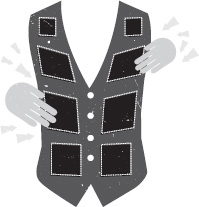Uncle John’s Bathroom Reader Weird Inventions (11 page)
Read Uncle John’s Bathroom Reader Weird Inventions Online
Authors: Bathroom Readers’ Institute


G
lam rock was in vogue among musicians in the 1970s—Elton John and David Bowie and their costumes could have inspired at least a dozen sci-fi and fantasy films between the two of them. But one of the more inspired—and functional—outfits from that era of music history has got to be Dan Hartman’s guitar suit.
Hartman was the bassist for the Edgar Winter Group, the blues-rock band that had hits with the songs “Frankenstein” and “Free Ride,” which Hartman wrote and sang. He also had a hand in designing his $5,000 wearable guitar outfit. The one-piece jumpsuit featured a bass-guitar neck attached to the side with strings over the abdomen, along with cordless pickups and amplifiers sewn throughout. (Sounds were relayed via radio signal to the mixing board.) Hartman told reporters that he could feel the music, as every note reverberated through his stomach and the rest of his body as he plucked the strings.
It definitely blurred the line between “clothing” and “musical instrument” and looked like something straight out of
Starlight Express
. In addition to being difficult to get through doorways and into bathroom stalls, the guitar suit was probably not the safest outfit ever designed. Let’s just say it’s not the sort of thing you’d want to be playing during an outdoor concert when a thunderstorm breaks out.
T
he $695 iGrow is a laser-powered helmet with hair-follicle-stimulating infared lights. As depicted on the models in the SkyMall catalog, it resembles an oversize bike helmet, with ear-covering headphones, that rests just above the head (to give the lasers room to do their magic), like an old-timey hair salon dryer. And those headphone-like things are actually headphones, so you can listen to music by plugging in your iPod while 51 laser/LED lights shoot beams at your receding hairline for an hour.
The validity of manufacturer Apira Science’s claims that this gizmo regrows hair is unproven, although the company claims that the iGrow was previously “sold exclusively to doctors for use in hair clinics around the globe,” meaning not the highly-regulated medical community of the United States.

A
s popularized by such movies as
The Deer Hunter
, Russian Roulette is a game that involves placing a single bullet in a gun’s chamber, spinning it, then putting the gun up to your temple and pulling the trigger. You win if you don’t blow your head off. We can all agree that Russian Roulette is a super-fun party game, but the only problem with it is getting the same group of good-time Charlies back together to play it again and again, because, as per the rules, somebody often dies mid-game.

Inventor Steve Zuloff came up with a way to make Russian Roulette fun for the whole family, and for people who don’t want to shoot themselves in the brain. His patent for “Game Device and Method Thereof” is a way to make Russian Roulette not deadly. A balloon is squeezed into a ring that attaches to the barrel of a toy gun. Each player takes a turn by holding the balloon part of the device up to their head, and then they pull the trigger. The gun then shoots either nothing (winner!) or a pin into the balloon (loser!).
Everybody lives! Unless, of course, the gun malfunctions and you shoot a pin into your ear or something.
S
ince time immemorial, nerds have dreamed of using futuristic, fantastical inventions in real life: X-ray glasses, jet packs, and the invisibility cloak, which, among futuristic gadgets, has always seemed the most out of reach. And yet a Canadian company called Hyperstealth, which specializes in high-tech camouflage technology, has developed a material that confers genuine invisibility upon the wearer. The product, Quantum Stealth, works by bending light rays to hide whatever’s underneath it from both the naked eye and infrared light. Just imagine all the geeky, pervy, and almost certainly illegal things you could do with a Quantum Stealth!
So can you get one before the first day of school at Hogwart’s next fall? Sadly, Hyperstealth repeatedly states on its website that all photos and product demonstrations of Quantum Stealth are mere mock-ups, and that “for reasons of security” they can’t discuss details of how the technology works or show images of it in action. So at best, the cloak is nowhere near being ready, and at worst, it’s a complete hoax. It may not matter ultimately, as Hyperstealth plans on offering Quantum Stealth only to militaries, and not to consumers. Sorry, Gryffindors.
T
here are a lot of novelty gifts out there that encourage the beer enthusiast to drink more beer: the classic beer helmet (plastic baseball-style cap that holds two beer cans, with a straw running down to the wearer’s mouth), and a thing we saw in a catalog, called the Beer Belly, a thick plastic bag that’s worn under a shirt and is outfitted with a straw that runs through out the collar to the mouth.

The Beer Belly (and its sister product, the Wine Rack, an alcohol-reservoir/brassiere) is designed to bring alcohol into places where alcohol isn’t allowed. The Keg Head, patented in 1999, is the complete opposite of that. It’s a hat, but it’s also a functional mini-keg of beer. Resembling an old-fashioned wooden keg, it comes complete with a tap, allowing the user to reach up in front of their face and fill up a glass with a fresh draught. Have you ever lifted even a small keg of beer? Would you want one sitting on your head? It’s not comfortable and would be quite heavy, but one side of the otherwise round Keg Head is tapered to fit firmly.
O
ne day, Japanese manufacturers will achieve their goal of turning every human being on the planet into the cutest robot/cartoon character ever. Until then, we’ll have to make do with devices such as Neurowear’s Necomimi Brainwave Cat Ears.
The device, which is basically a headband with a pair of fuzzy, pointed ears, has a forehead arm to detect neural activity (just go with it) and an earlobe clip to complete the circuit. In addition to making the wearer look like a telemarketer at a sci-fi convention, the Cat Ears are designed to read brain waves and convey the user’s neural activity. (Because actually showing emotions with your face and stuff is hard work, and really personal.)
Clearly, the engineers at Neurowear considered the entire range of human emotions and then decided to just go with just four. So when the user is concentrating, the ears perk up. When the user is highly interested in something, the ears perk up and wiggle. When the user is relaxed, the ears droop. When the user is both highly focused and relaxed, the ears wiggle up and down.
And when the user gets mad that they dropped $70 on a piece of gimmicky garbage, the ears twitch in a trash can.
Y
ou may not have noticed, but our society is in the midst of a dental crisis. Thanks to modern methods of food preparation, our cooked foods require little in the way of mastication (that’s fancy-talk for “chewing”). The result? Rotted teeth, underdeveloped jaws, and just generally poor self-image.
Or at least that was what Charles G. Purdy believed, which led him to invent a device to reverse this pernicious trend. Purdy’s patented teeth exerciser is basically just a mouth plate attached to a spring, which itself can be attached to a firm support (such as a wall) or to an exerciser plate in another person’s mouth. The wearer then moves their head back and forth, and the resulting stress from the spring causes tension in the wearer’s mouth. This stress is supposed to exercise the normally withered and useless muscles of the mouth and head, leading to improved oral health.
This sounds like a fairly sound concept, except for one glaring oversight. Based on what we’ve observed over the years, if there is one thing most people are already exceptionally good at, it’s ensuring that their mouths get plenty of exercise.
E
veryone is permanently affixed to their cell phones these days, and when you come to the rare place without reception or Internet data access, it’s maddening. And it’s a growing industry—a $4.5 trillion market for wireless technology over the next 10 years. But we can’t have wi-fi hotspots everywhere, can we?

We can. Chamtech Enterprises has developed a metal can fill of a liquid which is full of nano-capacitors, which, when sprayed on a surface—any hard surface—can receive radio signals and transmit them more effectively and efficiently than a metal rod or antenna can. Add in a router, and the antennas can communicate with a fiber network or receive signals from satellites, just like a phone. Result: a “mesh” network of low cost broadcast wi-fi virtually everywhere. And no ugly cell towers.
